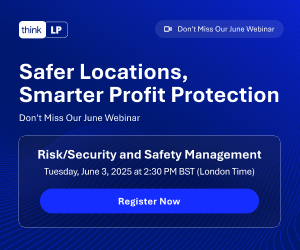Industry Focus
“Copse” and Robbers—When Can We See the Wood for the Trees?
From Zero to Anti-Hero—the Amplification of Retail Crime in the Age of Social Media
If a tree falls in the forest and no one is there to hear it, does it still make a sound?
Both factually and scientifically, the answer to this question is “yes”—the tree makes the sound. It is both the sound of creaking and snapping branches that the instinctive fight or flight brains of woodland creatures react to and the physical and environmental disturbance that physicists would call the “fluidic medium air”—the loud rush of wind pressure that emanates away from the falling tree as it hits the ground.
However, this literal answer misses the philosophical whimsy behind this question—the arrogant notion that a human being needs to be present to record and make sense of the event. As a uniquely inquisitive race we require empirical evidence before something can truly be claimed to be a fact.
This has also been the elusive requirement behind the reporting of retail crime. It has to make a sound, the pitch of which can be heard by all relevant stakeholders—from the retailer to the law enforcement community and ultimately the Government if it is to be believed.
It needs to be accurately recorded and measured for it to be counted and managed, an age-old conundrum where over the last twenty years we have failed to see the wood for the trees and where the sector and the law enforcement community have become so engrossed in the knotty threats to the thicket, they may also have lost sight of how to tackle the blight affecting the long-term sustainability of the forest.
The retail sector employs around three million people and is the largest private employer, contributing billions to the treasury in tax and business rates, and on top of this it is having to fund its own security measures—from security guarding to CCTV, and EAS, to body-worn cameras, not to mention the proposed roll-out of facial recognition technology that many are now investing in. Last year, the BRC reported that the industry spent £3.3 billion on measures to reduce retail crime, almost double what it spent the previous year.
However, over the last two decades, retailers and the law enforcement community of forty-three police forces have often been engaged in an almost tit-for-tat spat over poor policing response, the result of which has been the perception that store theft is seen as a low priority, the so-called “don’t report it unless it’s a theft of £200 or more”, although that was never an actual official police mandate.
Under-reporting was a challenge before, but this unofficial policy adoption provided an accelerant to the problem. The result was a spiralling of under-reporting of retail crime—in some cases even violent offences—because of the sense and wrong-headed narrative that theft is accepted as part of doing business and nothing was going to happen because the police had more important priorities—murder, rape, people trafficking, and terrorism, to name but a few.
The issue was further compounded by the austerity years post the financial crash when 20 per cent of frontline police resources were removed, and around 20,000 experienced officers left the force making the thin blue line even thinner.
The true picture of retail crime has been elusive depending upon the measurement and reporting methodologies. There is, for example, a difference in reporting of incidents within the business to actual reporting to the police.
The Re-Invention of Retail Crime
The noise around retail crime has become louder during the past twelve months, and more visibly attracting the attention of the mass media as more examples have come out of the woodwork.
The 2024 BRC Crime Survey revealed a doubling in the value of retail theft to almost £2 billion and a major spike in violent incidents from eight-hundred-and-seventy to 1,300 per day.
At the same time, the BRC figures reveal woeful police response times, with 44 per cent of retailers in its annual crime survey rating police response as “poor” or “very poor”. For one major retailer, the police’s own data shows that they failed to respond to 73 per cent of serious retail crimes that were reported, according to the BRC report.
There is a bigger perception of retail crime through the broadcast and print media as well as filmed incidents posted on TikTok in relation to steaming events and even so-called hashtag heists planned using social media platforms, bringing gangs into town and city centres with the sole intent of stealing with impunity.
The perception is of more crime, which most people accept is the case, but the reality is a spike in reporting as a result of media momentum creating what social scientists refer to as a “moral panic”—a term coined by sociologist Stanley Cohen—to describe “a condition, episode, person or group of persons who emerge to become defined as a threat to societal values and interests”.
The Today programme—Radio 4’s flagship news output—staged a radio debate in front of a live audience where Paul Gerard, head of public affairs at the Co-op said: “My colleagues will face one-thousand incidents of shoplifting and anti-social and threatening behaviour per day across our 2,500 stores.”
“The shopworkers union USDAW found that seven out of 10 shopworkers will be abused, and one in two will have suffered violence. It is physically dangerous, and it can be emotionally terrifying. If you have people coming in and rinsing the shop every day, it is debilitating, and your resilience dries up and it is no surprise that 35 per cent of shopworkers want to leave the sector,” he said.
In a separate report for the Today programme, Tom Gash of retail consultancy Leapwise and author of the book Criminal: The Truth Behind Why Good People Do Bad Things, said: “There has been a rise, but we have to see how real this rise is.”
He said the victims don’t report crime because they don’t think there will be a consequence, but they may reverse this decision if there is some kind of positive action.
“When something is getting a lot of attention, more things tend to get reported, particularly if they think that they are going to get some kind of response.”
“I think a lot of the rise in retail crime is real, but there is certainly a lot more reporting of crime,” added Tom, an advisor to the Institute of Government.
Priority Makeover
However, in the last twelve months, retail crime and anti-social behaviour has undergone something of a priority makeover.
In April, the Government reversed its previous decision on the introduction of a separate criminal offence for assault on retail staff in England and Wales as part of a response to the widely reported wave of retail crime.
The new legislation—resisted by the UK Government for the last three years after becoming law in Scotland in 2021—was, in the words of Rishi Sunak, a way of “freeing shops from the threat of crime or abuse”.
He said the new law was about sending a message to criminals stealing from local businesses or abusing shop workers that “enough is enough”.
The Government had previously argued it was not needed or effective but changed its approach because of campaigning retailers and its concern about an increase in attacks.
According to Emeritus Professor Adrian Beck, who has led research on shoplifting for ECR Retail Loss, retailers have seen an increase in the levels of loss they’re experiencing, but he says reporting of incidents is increasing.
Micro Moral Panics
“When you look at the issue around moral panics where we would see these things every now and again, the rise of social media means that we are almost witnessing micro moral panics with several instances recorded every day. It does not mean the untypical has become the typical and that it’s happening in every store across the UK, but there is an increased perception of it particularly in the world of social media where video streaming enables a picture to tell a thousand words,” said Adrian.
“In terms of the rise in incidents of out-and-out looting of stores, it’s not new—in the 1990s it was known as “steaming”—but when incidents go viral, it can both give the impression that this is happening more than it actually is, and it can also show others that shoplifting is easy, with little consequence. Very rarely do you see anybody getting arrested when these incidents happen,” Adrian continued.
Perfect Storm
While retail crime has long been an issue, Adrian said a “perfect storm” of several factors have come together this year to drive up figures.
Firstly, there is the cost-of-living crisis with people struggling to make ends meet—the so-called need versus greed store thieves—some of whom actually work in the retail sector themselves, which has triggered growing incidents of internal theft as well.
“At the same time, there is a growing concern that the police response is less than adequate,” he said, noting there seem to be fewer police on the beat these days.
“It’s a little bit like boiling a frog in some respects. Initially, you don’t really notice as you strip out the numbers, because people try to manage and cope. But over time, it begins to become more and more impactful, and people recognise that there are lots of vulnerabilities.”
The loss of police officers as part of the austerity drive has had an impact on police response to crime, and while the current administration argues it has restored the 20,000 lost officers, there is a long way to go in terms of the experience and effectiveness of raw recruits.
“What the Government never talk about of course is that a more appropriate measure of policing levels is the number of police officers per 100,000 of population. Since 2010 there has been an 8.2 per cent increase in the overall size of the population,” added Professor Beck.
As well as these factors that are outside retailers’ control, another part of the problem could be down to the business decisions the larger retailers have themselves made—namely moving towards self-service checkouts (SCO). With self-checkouts, where once a retailer might have had dozens of people working the tills, that space could now be operated by just a handful of colleagues.
“You’ve lost a lot of guardianship by having fewer people,” said Professor Beck.
Elsewhere, retailers have tried to reduce the barriers to their shopping experience.
“There are inevitable consequences to making the shopping journey as frictionless as possible, and the price to pay for reducing the controls you have in place is that you inevitably increase the opportunities for shoplifting and the risks associated with that.”
Professor Beck argues that with all of these factors, the balance of risk falls into four key area for those engaged in retail crime:
- What is the risk of getting caught?
- How easy is it to do?
- What is the reward?
- What are the consequences of getting caught?
Currently, the risk of getting caught is low and it is easy to do, particularly when retailers are adopting non-arrest policies because of their over-riding duty of care approach and concern over levels of violence. There have also been brazen images of intimidation where thieves enter a store and tell staff they are going to steal and simply walk out with the goods. In community stores where staff live in the same area as persistent and prolific offenders, there have been incidents of threats about following staff home or even against their children.
The reward is obviously what Professor Beck calls “easy access to free stuff” which can be sold on for profit or to feed an addiction, and in light of the fact of “no detaining of thieves” policies and poor police responses, there are currently no serious consequences—they know that if they do get caught, they are unlikely to face any serious sanction.
Even the new specific offence of assault against a retail worker may not have the desired effect. The charity Transform Justice argues that although it will carry a maximum prison sentence of six months in jail, an unlimited fine, the mandatory wearing of tags for persistent offenders, and a shop ban, it is unlikely to reduce attacks on retail workers.
It cited evidence that a new offence of assaulting an emergency worker introduced in 2021 had not seen the number of attacks fall.
According to the Scottish Grocery Federation, convictions made under Scotland’s Protection of Workers Act are “not high enough”, with just 11.6 per cent of reported cases by retailers resulting in conviction since the law’s introduction almost three years ago.
Transform Justice also argued that the new law will potentially contradict another piece of legislation aimed at reducing prison populations.
Anyone convicted of the new offence in England and Wales would not routinely go to prison because, under the Sentencing Bill currently making its way through Parliament, jail terms of twelve months or less would be suspended and served in the community, although jail could be imposed in exceptional circumstances.
The Government optics around tougher sanctions have continued with the launch of the Retail Crime Plan, which includes a police commitment to prioritise urgently attending the scene of shoplifting instances involving violence against a shopworker, where security guards have detained an offender, or where attendance is needed to secure evidence.
A specialist new police team called Pegasus has also been created to, according to the Home Office, “build a comprehensive intelligence picture of the organised crime gangs that fuel many shoplifting incidents across the country, to help target and dismantle them”.
This is backed financially by a number of national retailers who are funding the analyst team operated through Opal, the UK-wide police acquisitive crime division.
While recognising that any extra help is welcomed by the retail community, Professor Beck says focusing on prevention could be more effective than trying to “arrest your way out of a loss problem”.
“Business is tough, and I have a lot of sympathy with both the police and retailers, but there have been cyclical challenges and probably naivety in decision making where lack of reporting and police numbers have had an impact,” he continued.
“If you take away officers during the austerity period it’s going to be a long time before you can replace that experience. Likewise, if you introduce technology into your store that increases risk, there are inevitable consequences.”
“Retailers have to think ultimately how they’re going to protect their own environment, think through those consequences of the business choices that they’ve made, and work out what is the best way in which to protect it.”
“This could include looking at how they are marketing and designing their stores, to how they are using technology and staff in their spaces.”
He welcomed moves by some retailers that have put in place a more “design out crime” approach in their stores.
Here, cross-departmental “gatekeepers” proactively deter crime through effective risk assessments which includes the reviewing of proposed new projects in order to identify risks and potential mitigations. The purpose of this approach is to allow the “proposition owners”—the departmental heads from operations, merchandising, retail, or marketing, for example—to make more informed decisions about the project and its potential for risk.
The role does not deny the proposition owner the ability to implement a strategy but presents a “pause moment” to assess and review the potential for risk with the ultimate proviso that they take ownership of any losses flowing from implementation.
“Taking ownership of a risk is a good way of managing risk within the business,” Professor Beck added.
Reporting
Professor Beck said that greater reporting is a solution, but it has to be both easy and practical to achieve.
The plethora of different incident reporting platforms operating in the UK and their links to police digital evidence management systems (DEMs) to expedite investigations makes for a clearer road map of better management of retail crime. There are also the political concerns of the potential for millions of extra cases being reported to the police and how forces could manage if this became a reality.
There have been incidents where retailers have been warned-off reporting crime by police fearful of being made to look bad by their clear-up statistics in light of the pressure of targets set by Government. These have often come in the form of the threat of losing an alcohol licence, for example, another nod to the school of thought that informs retailers that they are still on their own when it comes to dealing with the problems of retail theft.
The reality of the situation is the need for a grown-up conversation around the true extent of retail crime through the accurate reporting, recording, and measurement of it—an objective that Pegasus is looking to address in relation to organised travelling retail crime.
It is only when retailers and police have a true picture of the crime landscape across the UK that it can be properly managed, and detection and deterrence rates can be established.
Only by doing this can we make the right noises, so everyone hears and recognises what needs to be done. This amplification would at last provide the Government with the narrative to correctly resource police forces to address the issue so that we can all at last see the wood for the trees.






